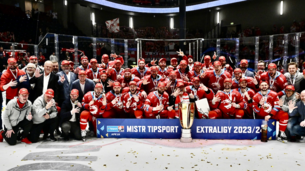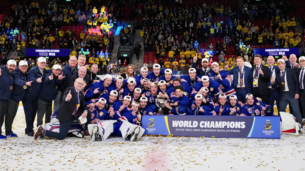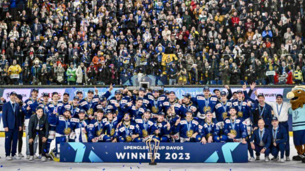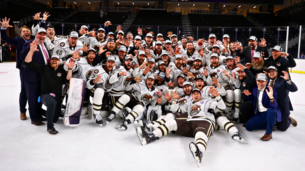ABU DHABI – There are several places where demand for hockey is increasing much faster than the rink capacities.
There are countries in colder regions with needs of more infrastructures. Last summer for example we reported about the situation in Iceland where, paradoxically, there’s not enough ice for the growing number of players and teams. But ice hockey is also flourishing in regions many people might not imagine it. For example: in the United Arab Emirates and other Gulf States.
Even though the temperature is hotter than 40°C (100°F) these days, there are quite some people who think about playing ice hockey despite the heat. Or one could say because of it. Winter sports have become trendy in the oil-rich country. Apart from four ice rinks, the Emirates also hit the headlines when a 22,500-square metre indoor ski resort opened in Dubai in 2005.
The International Ice Hockey Federation has hosted several events on the Arab peninsula, such as the Challenge Cup of Asia, or the recent Asian Hockey Development Camp in Abu Dhabi.
“Ice hockey has been growing rapidly in popularity in the Middle East,” said Jukka Tiikkaja, the IIHF’s Asian Sport Development Manager. “One main challenge is to find people to drive the grassroots programs rather than just focusing on national team activities.”
For a long time the United Arab Emirates, who became an IIHF member in 2001, haven’t been very active internationally although games have been played since the ‘70s. While the focus was first to build a national team, which participated in one IIHF World Championship Division III in 2010, the country’s hockey body founded a permanent national league in 2009 with two Arab and three expat teams in three cities.
The United Arab Emirates currently list 532 ice hockey players, including 40 female players. Four years ago there were only 195 players registered in the country. But the growth also brings problems with the existing infrastructure for ice sports.
“The United Arab Emirates are an ideal example of the possibilities you have when there are resources and, more importantly, people with enthusiasm and vision,” Tiikkaja said.
“Three years ago the focus was around the senior national team, and junior programs were virtually non-existent. This strategy has changed and it has had a remarkable impact with the demand exceeding the supply.”
For the players, teams and hockey schools that face problems getting ice time at the rinks there’s hope for change. The National reported recently that the government is set to sanction the construction of two new ice rinks in Abu Dhabi, the Emirati capital, to help satisfy growing interest in ice hockey and underline the national team’s ambitions to climb up the ladder in the IIHF World Championship program.
“We have been talking to the government about building two rinks at Zayed Sports City where the present one stands,” Mohamed Aref, the country’s ice hockey technical director, told the newspaper.
“We need more ice rinks and I believe that will happen. Right now we have one Olympic-sized venue in Dubai [at Dubai Mall], one in Al Ain and this one in Abu Dhabi. Just imagine if we get to 2015 with the same amount of rinks. By that time the sport will have grown even more. How would we cope with so many people?”
Aref believes that the increasing demand comes not only from the hockey schools and clubs founded in the last ten years, but also because of the success of the national team. Not many Arab athletes bring home medals and trophies from international sport events, but the ice hockey national team has won the Challenge Cup of Asia in 2009 and the bronze medals in the Premier Division of the 2011 Asian Winter Games.
“I had heard this is going to happen and that is unbelievable,” national team player Faisal Saeed said about the plans of building new rinks. “I’m so proud of how big ice hockey has become in my country and the structure we have now. However, we do need more rinks.
“There are a lot of kids waiting to play this sport, but we don’t have enough ice time for them. If we had more rinks, then we could really move the sport forward. We need to expand and I hope we do that.”
Now the Emirati want to look up to the top nations with the prospect of additional rinks. They think about an entry in the IIHF Ice Hockey World Championship program for 2013. The first goal is to qualify for the Division III, but the dream is to become the first Arab team to challenge the traditional powerhouses from North America and Europe in the Top Division one day.
Prior to that, the Emirati Ice Hockey League will kick off its third season on 5th October with the same five teams, but there are talks about a sixth team in the future if such a team could be competitive.
While the UAE has been the most successful Arab nation in hockey so far, there are other countries from the Middle East that have discovered ice hockey.
Kuwait also started the game in the ‘80s and rejoined the IIHF in 2009 after a period of inactivity. Its national team has played in two Challenge Cups of Asia and in the Asian Winter Games and has won some games in these tournaments, although it couldn’t overcome its Arab rival from the UAE.
Kuwait has 229 players and two ice rinks. One of them hosted the Challenge Cup of Asia in April.
Ice hockey is a chance for many kids to try something new with a cool and modern flavour. Compared to sports that are more established in these countries, ranging from camel racing to football to water sports, it’s kind of a break from the standard pattern of the sport landscape.
Same as in the Emirates, the percentage of women and girls playing ice hockey is surprisingly high. Actually, Kuwait has the highest percentage of female participation among all 70 IIHF member nations with 37.1 per cent (85 out of 229 players) and also the UAE’s number of 7.5 per cent is higher than in most European top-tier countries where ice hockey used to have the image of being a sport for tough guys only.
In nations where ice hockey is something rather new and there’s no gender bias in the hockey family, it seems to be a different story and girls enjoy playing the sport same as boys do.
Kuwait and the United Arab Emirates are the only IIHF members from the Arab peninsula (Morocco from North Africa is another Arab country in the IIHF), but ice hockey is in the fledgling stages in other countries of the Middle East as well.
The national team of Bahrain appeared on international ice for the first time in the 2011 Asian Winter Games, but the team was not able to cope with its opponents yet, conceding between 15 and 29 goals each game.
One year ago, Kuwait City hosted the first Gulf Ice Hockey Championship that included two new national teams, Saudi Arabia and Oman. The teams were also struggling with their more experienced opponents from Kuwait and the UAE, but Saudi Arabia won its first international hockey game, 3-1 against Oman.
Another Gulf state has avoided international hockey yet. Qatar had to cancel its participation in the Asian Winter Games in the last minute, but the country that was in the spotlight for its successful 2022 FIFA World Cup bid held its first national ice hockey championship last season. Qatar 1 became champion after defeating Sand Storm 5-2 in the final match. Qatar 2 and Desert Heat were the other teams in the league that included Qatari and expat players.
MARTIN MERK
This article originally published at http://IIHF.com
View video of Emirates Ice Hockey League here http://wn.com/Emirates_Ice_Hockey_League
 Back
Back









